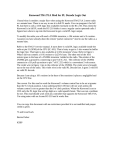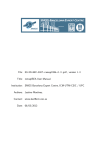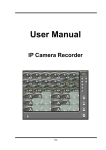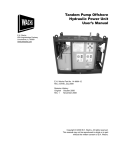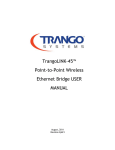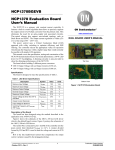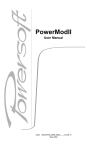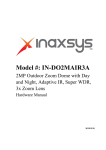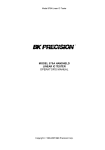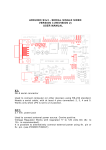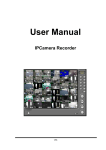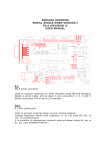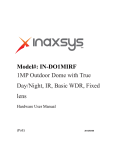Download rc2102_5assembly 647KB Aug 31 2006 05
Transcript
Arcom Communications 24035 NE Butteville Rd Aurora, Oregon 97002 (503) 678-6182 arcom@ah6le.net RC-210 Repeater Controller Assembly Manual Hardware Version 2.5 Reproduction or translation of any part of this manual beyond that permitted by sections 107 or 108 of the 1976 United States Copyright Act (or its legal successor) without the express written permission of Arcom Communications is unlawful as noted below. Requests for permission to copy or for further information should be addressed to Arcom Communications. Except as noted above, permission is hereby granted for any non-profit group or individual to reproduce any portion of this document provided that: the reproduction is not sold for profit; the intent of reproduction is to further disseminate information on the RC-210 Repeater Controller kit; the reproduction is not used for advertising or otherwise promoting any specific commercial product other than the RC-210; and full credit is given to Arcom Communications as the original source of information. The information contained in the manual has been carefully checked for accuracy and is believed to be entirely reliable. However, no responsibility is assumed for inaccuracies. Arcom Communications reserves the right to make changes in the RC-210 Repeater Controller kit to improve reliability, function or design without obligation to purchasers of previous equipment. Arcom Communications does not assume any liability arising out of the application or use of any product or circuit described herein; neither does it convey license under its patent rights or the rights of others. Parts List Integrated Circuits Check off the part in the space provided as you locate and verify against this list. Do not handle the IC's unnecessarily. Carefully remove the IC tubes from the anti-static bag and check each one against the parts. Then return the tubes with the ICs to the bag. Resistors, 1/4 watt ( ( ( ( ( ( ( ( ) 18 )8 )3 )6 )3 )3 )3 ) 11 10k ohm (brown-black-orange-gold) 22k ohm (red-red-orange-gold) 47k ohm (yellow-violet-orange-gold) 100k ohm (brown-black-yellow-gold) 470k ohm (yellow-violet-yellow-gold) 33k ohm (orange-orange-orange-gold) 270k ohm (red-violet-yellow-gold) 470 ohm (yellow-violet-brown-gold) ( ( ( ( ( ( ( ( Resistor Network ( )1 ( ( ( ( ( 10k ohm (C103) 500k ohm (C504) Capacitors ) 19 )2 )2 )3 )3 .1 uf 33pf 22pf .0068uf .47uf )4 )8 )3 )1 )1 (104) (330) (220) (682) (474) )4 ) 22 )4 )4 )4 ( ( ( ( ( ( ( 1 uf 2.2 uf 22 uf 47 uf 10 uf 5.0 volt 3.3 volt (LM340T5 TO-220 case) (CZ-3.3, TO-92 case with piece of tape on leads) )3 )1 )3 )1 )1 )2 )1 9-pin female right-angle PC mount 25-pin female right-angle PC mount RJ45 modular jack 4 pin power female PCB power 4 pin power male plug 36 - pin single row header PC mount 10 pin dual row header PC mount Misc. ( ( ( ( ( ( ( ( ( ( ( 1N4001 Rectifier 1N4148 Silicon Diode Red LED Green LED Yellow LED Transistors ( )8 18-pin DIP Socket 24-pin DIP Socket 28-pin DIP Socket 14-pin DIP Socket 16-pin DIP Socket Connectors Diodes ( ( ( ( ( )3 )1 )1 )2 )5 ( )1 ( )1 Electrolytic Capacitors ( ( ( ( ( (64 pin TQFP) (28 pin DIP) (16 pin DIP) (24 pin DIP) (18 pin DIP) (16 pin DIP) (14 pin DIP) (16 pin DIP) Voltage Regulators Capacitors may be marked in various ways. The typical markings are given but may vary. ( ( ( ( ( ATMega128 (mounted on PCB) ISD4003-04MP VoiceCorder ULN2003A MT8806 Crosspoint Switch MT(CM) 8870 DTMF Decoder MAX232 Level Translator TL064 Operational Amp 74HC595 Shift Register Sockets 470 ohm network (10 pin SIP) Potentiometers ( )6 ( )3 )1 )1 )2 )1 )3 )1 )2 )2 2N3904 NPN 2 )1 )1 )1 )1 )1 )1 )1 ) 15 )1 )1 )1 Heatsink 4-39 screw and nut assembly 3.579 Mhz crystal (3.57ECSV) 16 Mhz crystal (160ECSV) 32768 Khz crystal (small cylindrical) 10 uh choke (silver-black-black-red-silver) Self-resetting Fuse (X0101) Push-on jumpers PC Board (revision 2.5) Assembly Manual User Manual Construction Install the following resistors 10K (brown-black-orange-gold) resistors: You are now ready to begin construction of the RC-210. Use a temperature controlled, fine-tipped soldering iron and good quality 60/40 rosin-core solder for construction. Follow standard construction practices when building the unit. ( ( ( ( ( ( You will also need small flush or semi-flush cutting pliers and small-tipped needle nosed pliers. A magnifying glass may prove useful for identifying the values of small parts. ) R13, R14, R15 ) R32, R33, R38 ) R45,R46, R48 ) R49, R51, R54 ) R58, R60, R61 ) R62, R63, R64 Install the following 47K (yellow-violet-orange-gold) resistors: Keep the tip of the soldering iron bright and clean, wiping it frequently on a wet sponge or rag. Make solder joints carefully, but swiftly. Prolonged heat on a PC board pad can be disastrous and ruining this PC board can be expensive! Two or three seconds should be enough time to apply heat to any joint. Follow the order of construction, as they have been developed to make installation of parts as easy as possible. ( ) R50, R52, R53 Install the following 22K (red-red-orange-gold) resistors: ( ) R24, R25,R26, R27 ( ) R31, R37, R39, R40 Install the following 470K (yellow-violet-yellow-gold) resistors: The microprocessor (ATMega128) has already been soldered on the board. Great care should be taken when assembling the RC210 to ensure there are no static discharge issues. The use of a grounding wrist strap and grounded tip soldering iron is highly recommended. (Note: DAMAGE DUE TO STATIC DISCHARGE IS NOT COVERED UNDER WARRANTY) ( ) R29, R30, R36 Install the following 33K (orange-orange-orange-gold) resistors: ( ) R35, R41, R56 IC Sockets Install the following 100K (brown-black-yellow-gold) resistors: Note: If any sockets are bent, carefully straighten them with a pair of needle-nose pliers. When installing IC sockets, double check to ensure that the socket is seated properly against the board with the notch, beveled corner or "1" towards the silkscreened reference (U1, IC2, etc). Be sure all IC socket pins are showing on the solder side of the board. While making certain the IC socket is tight against the PC board tack-solder two diagonally opposite corners (such as pins 1 and 14 on a 14 pin socket). Then solder the remaining pins of that socket before proceeding to the next one. If you find a socket is difficult to install, remove it and check for bent pins. ( ) R1, R2, R3, R4, R5, R9 Install the following IC sockets. ( ) R6, R7, R8, R16, R17, R18 ( ) R19, R20, R21, R22, R23 ( ( ( ( ( ( ) ) ) ) ) ) U6 U1, U2, U3 U4, U5 U7 IC2, IC3, IC4 IC5, IC6 Using a cut-off part lead, install a wire jumper at R57: ( ) R57 wire jumper Install the following 270K (red-violet-yellow-gold) resistors: ( ) R10, R11, R12 Install the following 470 ohm, (yellow-violet-brown-gold) resistors: 24-pin 18-pin 14-pin 28-pin 16-pin 16-pin Potentiometers Carefully bend the three leads of each trim pot over 90 degrees, so the leads face the back of the trim pot body. Then insert the leads through the holes in the PC board, with the body closest to the edge of the board, it is flush against the board. Then solder the connections. (note: the pots should lay down against the board, with the adjustment slot facing up) Now check all your work. All leads should be soldered with no solder bridges or cold solder joints. 10K ohm (C103) Resistors ( ) Port1 Disc, Port2 Disc, Port3 Disc ( ) Record, Play, Tone Resistors lie flat on the PC board and have a lead spacing of 0.5". You may wish to use a lead former to preform the resistor leads for the neatest appearance. 500K ohm (C504) ( ) P1 Tx, P2 Tx, P3 Tx 3 Capacitors ( ) P1Dtmf ( ) P2Dtmf ( ) P3Dtmf Red Led The following capacitors are .1uf (104) and should be mounted as close to the board as possible without stressing the leads. Transistors ( ) C1, C3, C5, C6, C9, C14, C15, C16, C17 ( ) C19, C20, C22, C32, C33, C34, C35, C42 ( ) C43, C45 All transistors should be installed with the body not more than 1/4" above the PC board. Match the body of the transistor with the outline on the board and carefully bend the leads to match the hole pattern on the PC board. All transistors are 2N3904 Green LED Yellow LED Install the .0068 uf (682) capacitors ( ) Q1 - Q8 ( ) C27, C28, C31 Connectors Install the following capacitors: ( ) C18, C21 ( ) C7, C8 ( ) C23, C24, C25 Carefully install J1 taking care that no pins are bent over as you insert them. Holding J1 flush against the PC board, solder two opposite pins in order to the hold it in place. Then solder the remaining pins, taking care to avoid solder bridges 22pf (220) 33pf (330) .47uf (474) Electrolitic Capacitors Solder the two larger holes (one on each end) to the pads on the PC board. Use lots of solder to make a mechanically secure connection. These capacitors are polarized, so care should be taken to orient them properly. Note that at the installation positions for these capacitors, the PC board is marked with a plus (+). Note that the capacitors have the minus (-) lead marked. Install accordingly. ( ) J1 25-pin female right-angle PC mount The following are all 2.2uf. Your RC-210 kit comes with 2 types of connectors for J2, J3 and J4 - either DB9 or RJ45 modular jacks. You must now decide which you prefer to use. You may want to read the "Choosing Your Connector" section at the end of this manual before proceeding with this step. ( ) C26, C30, C36, C37, C38, C39, C41, C46 Install the remaining electrolytic capacitors: ( ( ( ( ) C4, C11, C13, C99 ) C10 ) C29, C40, C44 ) C12 1uf 47uf 22uf 10uf ( ) J2 ( ) J3 ( ) J4 Diodes RJ45 or DB9 female right angle PC mount RJ45 or DB9 female right angle PC mount RJ45 or DB9 female right angle PC mount Diodes are polarized devices, with the cathode end being banded. Observe polarity when installing the following diodes. Install the Phoenix PC mount 4 pin jack at the location on the PC board marked "Power". It should be installed so it fits inside the outline marked on the PC board. ( ) D1, D2, D3, D5 ( ) Power 1N4001 Install the following 22 ea. 1N4148 diodes: Voltage Regulators ( ) D11, D12, D13, D14, D15, D16, D17, D18, D20, D21 D22, D23, D24, D25, D26, D27, D33, D34, D35, D36, D37, D38 IC1 is installed upright on the PC board with the metal tab lined up with the dark line on the silkscreened outline on the PC board and should be spaced 1/4 above the surface. LEDs ( ) IC1 Install the LEDs. Note that one side is flat; this is the cathode. Be sure to the flat side of the LED so it lines up with the flat side on the PC board. Install these 1/2" above the board to allow them to be bent over later. ( ) P1Key, P2Key, P3Key ( ) P1Cos, P2Cos, P3Cos ( ) P1Ctcss, P2Ctcss, P3Ctcss 4 pin (green) 78M05 (LM340T5) Install the heatsink onto the metal tab of IC1 with the 4-40 hardware provided. Then, cut off the excess length of the screw. IC7 looks like a transistor. It should be installed just like the transistors. Red LED Green LED Yellow LED ( ) IC7 4 78L033 (CZ-3.3) Inductor Jumper Headers L1 looks like a 1 watt resistor. Bend one lead over and install it vertically on the board. Locate the 2 - 32 pin jumper header connectors. Carefully cut them between pins (in the notches in the plastic) to create the following: ( )1 ( ( ( ( ( L1 (silver-black-black-red-silver) Crystals Install the following 2 crystals with the body 1/8 inch above the surface of the PC board (Caution: Make sure you space the crystal as stated, to avoid shorting traces on the PC board). ( ) Y1 ( ) Y2 3.579 Mhz crystal 16.00 Mhz crystal ( ( ( ( ( ( ( ( ( ( (3.57ECSV) (160ECSV) 32768 Khz crystal Fuse ( ) 10 pin 2 pin 3 pin 6 pin 4 pin 3 pin 2 pin 3 pin 3 pin 3 pin J5 Locate the push-on jumpers and slide them over pins 1 & 2 or 2 & 3 of the jumper headers depending on your COS polarity requirements. Don't worry if you don't know which you need right now, as you can easily change them later. Fuse Resistor Network ( ) JP1, JP2, JP3, JP4, JP5, JP6 The resistor network is a 10 pin single in-line package, colored black. There is a white dot on one end, which indicates pin 1. Line pin 1 up with "1" marking silkscreened on the PC board at RN1. ( ) RN1 ) J8 ) JP14 ) J6 ) J7, J9 ) JP7, JP8, JP9 ) JP13 ) JP10, JP11, JP12 ) JP1, JP2 ) JP3, JP4 ) JP5, JP6 Now install J5, the 10 pin dual row header The RC-210 uses a special, self-resetting fuse. It looks like a yellow ceramic capacitor and is marked "X010" ( ) F1 10 pin 3 pin 4 pin 6 pin 2 pin Install the following pin headers you just created: Crystal X1 looks differently from the other 2 crystals - it is a small, cylindrical type with close-spaced leads. X1 should be mounted 1/4 above the PC board, then bent over so it lays flat against the board, away from the Mega128. ( ) X1 )1 )8 )3 )2 )4 Install push-on jumpers over the center 2 pins (pins 2 & 3) of JP7, JP8 and JP9. This completes the audio path for the receiver amplifiers when the audio delay board is not installed: 470 ohm resistor network ( ) JP7, JP8, JP9 Install a push-on jumper between pins 2 & 3 of JP13. This allows the DVR chip to communicate with the CPU. This is very important! ( ) JP13 Double check your work. ( ) All solder connections are bright and shiny. ( ) No solder bridges between IC socket pins. ( ) All components installed in their correct positions. ( ) Diodes, transistors, voltage regulators and electrolitic capacitors installed with their proper polarity. 5 Congratulations! At this point your RC-210 is completely assembled except for the integrated circuits. These will be installed after you run some voltage checks. Checking Voltages For these tests, you will need to connect power to the RC-210. It is suggested that you use a power supply with current limiting "just in case". Locate the green, 4 pin power plug and connect it as follows: Pin 1 Pins 3 & 4 +11.5 to +15 Vdc Ground (both of these pins MUST be connected to the power supply's negative leads) Meter Plus Lead ( ( ( ( ( ) IC2, pin 16 ) U6, pin 24 ) U5, pin 4 ) U5, pin 12 ) U7, pin 27 Meter Minus Lead Ground Ground U5, pin 11 U5, pin 11 U7, pin 12 Result +5 ± 5% Vcc ± 5% * Vcc ± 5% * 1/2 Vcc ± 5% 3.3v ± 5% * Vcc refers to the voltage supplied to the RC-210. If you do not obtain the results above, carefully check the PC board for cold solder joints, bridges or unsoldered connections. If all is well, remove power. You're now ready to install the socketed integrated circuits. ( ( ( ( ( ( ( ) U1, U2, U3 ) IC2 ) IC3, IC5 ) IC4, IC6 ) U4, U5 ) U6 ) U7 MT(CM) 8870 MAX232 74HC595 ULN2003A TL064 MT8806 ISD4003-M4 Your RC-210 is now ready for installation and programming. Please consult the Operations Manual. 6 If You Need Assistance We offer several ways you can obtain assistance with your RC-210: Our Website: http://www.ah6le.net/arcom/help.html Our email list (it's a good idea for all RC-210 owners): Send an email to: rc110-subscribe@yahoogroups.com Or you may contact us directly at: Arcom Communications 24035 NE Butteville Rd. Aurora, Oregon 97002 (503) 678-6182 email: arcom@ah6le.net 7 Choosing Your Connector Some repeater owners prefer the advantage of being able to easily solder/unsolder connections and experimenting by using DB9 style connectors for the radio ports while other owners prefer the advantage of being able to quickly crimp a connector on a cable. Whichever style connector you prefer, the RC-210 gives you the flexibility to use either (or a mixture of both!) styles. If you chose to install the DB9 style for all three of the radio ports, simply install them at the positions marked J2, J3, and J4. If you chose to install the RJ45 style for all three ports, they should be installed to the right of the labeled port, in the rectangular outline on the PC board. The two downward facing plastic tips insert into the holes and the whole connector should snap into place. You can then solder the pins. Since each port on the RC-210 operates identically to the others, some owners may prefer to have one style connector for some port(s) and the other style for other(s). If you choose to "mix and match" in this manner, you must use an RJ45 for Port 1 and then decide on the other two. Just remember that putting an RJ45 jack in the Port 3 position takes eliminates the ability to mix jack styles and retain 3 ports. If you want to mix connectors, take a few minutes with the unmounted connectors and the board. You'll soon see the combinations that will work, as well as those which won't. 8









